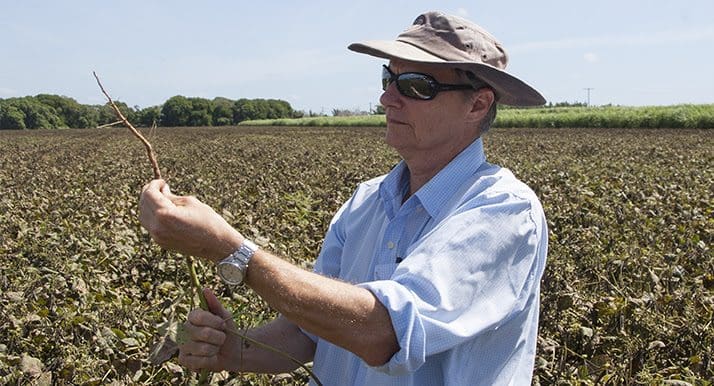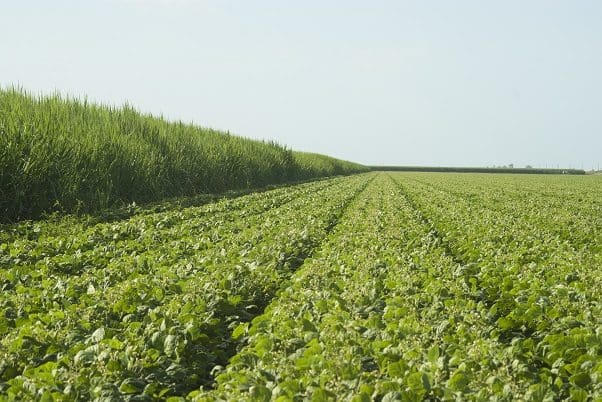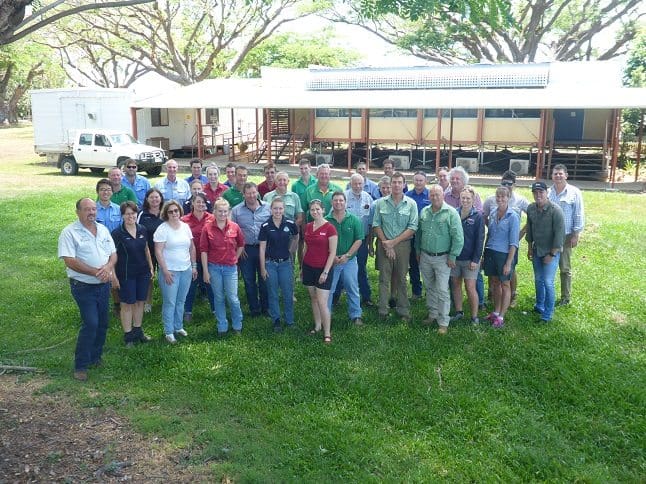FINDING a suitable crop to grow in rotation with sugarcane in the Burdekin region of far north Queensland has been an on-going challenge for growers and researchers.

CSIRO researcher, Dr Stephen Yeates, is convinced that significant advances are possible for mungbeans in the Burdekin through fine-tuning the agronomy and removing the genetic constraint to flowers per plant to achieve yields well above the current 2.5t/ha for well-grown crops in the region.
In the short term it is hard to beat back-to-back sugarcane crops however, even in the Burdekin, yield decline in sugarcane monoculture is a reality.
CSIRO researcher Dr Stephen Yeates has a long association with tropical agriculture and his experience with mungbean dates right back to research work in the Kimberley region of WA and in the Northern Territory in the 1980s and ‘90s.
He is currently supported by the Grains Reseach and Development Corporation (GRDC) to assist farmers in developing optimal management practices and to identify varieties of mungbean suited to the Burdekin and NQ region.
“Being a tropical legume, mungbean is well suited to this area and the strong demand for mungbean is making it a very attractive option for growers,” he said.
“To make the most of this crop though we have been investigating the basic agronomic parameters such as sowing dates, row width and irrigation timing that generate the most reliable and high-quality results from the current and upcoming varieties.”
Fit in cane rotation
Mungbean is a good fit in the cane rotation as it is a quick crop that can fit around cane planting and harvest times.
Taking only 80 days from planting to harvest under irrigation in the Burdekin, mungbean provides an excellent opportunity to control grass weeds after cane while earning a solid return.
Mungbeans grown in the Burdekin are generally irrigated, high-input crops grown on small parcels of land.
In the 2015–16 season the area sown to mungbean in the Burdekin increased by about 60 per cent to an estimated 2500 ha or more, adding to the record-breaking Australian crop for that season. A similar area was planted in 2016–17.
Ideal growing conditions
Climatic analysis shows that the Dry Tropics provide ideal growing conditions for mungbeans, with an abundance of sunlight and plenty of rain and irrigation water available over a long period.
“The key is to look for a time of the year when it is least likely to rain at harvest, and work backwards to choose a good time to sow,” Dr Yeates said.
“Mungbean plants need to ripen in fine weather and can be weathered if as little as 30 millimetres of rain falls on the ripening pods.”
Mungbeans grow best when the average daily temperature is between 18 and 29˚C and sunlight and moisture are not limited, making spring planting an option for this region.
The recommendation with current varieties is to avoid planting between October and January to reduce the risk of weathering damage to the grain.
Planting in late August or early September will see the crops finish before the wet season begins and planting in February or March still allows the crop to be harvested before the next cane crop is planted.
Water efficiency
Mungbean is very water efficient, requiring 3 megalitres/hectare compared to the 14ML/ha used to produce sugarcane, and produces less trash than alternative break crops such as rice and corn.
“Yield is generated in the last 30 days, so the timing of management decisions is critical,” Dr Yeates said.
“Warm temperatures and low humidity allows the pods to ripen in just 10 days and so the timing of the last irrigation is very important.”
A drying soil stimulates the plant to start the desiccation process and so a late irrigation or rainfall event can create harvest difficulties through high plant moisture content.
Being indeterminant, mungbeans will keep growing, and flowering, while moisture is available and they do not always respond to chemical desiccation.
Dr Yeates conducts irrigation scheduling experiments in the winter when it is unlikely that rain will influence the results.
Mungbeans respond quite differently to late season irrigations compared to soybeans, which generally benefit from a late irrigation to finish off.
Variety potential
While the current varieties are well suited to the Burdekin region Dr Yeates believes the climatic conditions in the region will support many more flowers than the current varieties produce.
Yields of 2.5t/ha are common on the well-drained soils in the region and Dr Yeates sees potential to increase this yield through fine-tuning the agronomy and removing the genetic constraint to the number of flowers per plant.
“The second flush of flowers come about 21 days after the first, potentially adding 30–40 per cent in yield, or rescuing a crop if the first flush is weathered, however, waiting for the second flush extends the growing period and it would usually be better to have more flowers on the first flush and to harvest at the earliest opportunity,” he said.
“We have a truly tropical variety, called Putland, that will flower in March when planted anytime from late December to mid-February.
“Characteristics like this can take some of the pressure off growers to get crops planted within a certain window to ripen at the optimum time.”
While only a small amount of Putland seed is available, this trait may be useful in future plant breeding programs to develop varieties specifically suited to the region.
Dr Yeates is working in partnership with the National Mungbean Improvement Program to screen new varieties for their suitability for the Dry Tropics region.
Agronomy training
Australian Mungbean Association (AMA) president, Mark Schmidt, said more than 30 agronomists recently attended the industry’s best management practice training in Ayr, testament to the benefits of mungbeans to the Dry Tropics’ farming systems.
“The participation of so many agronomists in the accredited training program demonstrates their dedication to improving returns for growers in the Far North, and the role that mungbeans can play as a rotation crop and as a valuable crop in its own right,” he said.
“The mungbean industry Accredited Agronomists program is highly regarded and the AMA strongly encourages growers to engage agronomists and crop consultants who have invested their time in becoming accredited so they can offer expert advice and assist growers with key management decisions. Within the last few months over 100 agronomists have attended training courses held in Ayr, Emerald and Toowoomba to either gain new skills or refresh their mungbean management knowledge and more courses are planned for northern NSW.”
The Mungbean Accreditation courses are conducted by Pulse Australia’s Paul McIntosh in conjunction with a team of experts from the Department of Agriculture and Fisheries, NSW Department of Primary Industries, CSIRO and the AMA.
Source: AMA, www.mungbean.org.au



HAVE YOUR SAY